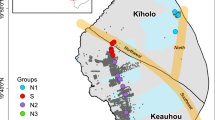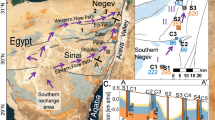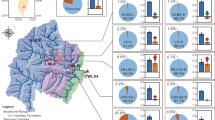Abstract
Although microbes are known to influence karst (carbonate) aquifer ecosystem-level processes, comparatively little information is available regarding the diversity of microbial activities that could influence water quality and geological modification. To assess microbial diversity in the context of aquifer geochemistry, we coupled 16S rRNA Sanger sequencing and 454 tag pyrosequencing to in situ microcosm experiments from wells that cross the transition from fresh to saline and sulfidic water in the Edwards Aquifer of central Texas, one of the largest karst aquifers in the United States. The distribution of microbial groups across the transition zone correlated with dissolved oxygen and sulfide concentration, and significant variations in community composition were explained by local carbonate geochemistry, specifically calcium concentration and alkalinity. The waters were supersaturated with respect to prevalent aquifer minerals, calcite and dolomite, but in situ microcosm experiments containing these minerals revealed significant mass loss from dissolution when colonized by microbes. Despite differences in cell density on the experimental surfaces, carbonate loss was greater from freshwater wells than saline, sulfidic wells. However, as cell density increased, which was correlated to and controlled by local geochemistry, dissolution rates decreased. Surface colonization by metabolically active cells promotes dissolution by creating local disequilibria between bulk aquifer fluids and mineral surfaces, but this also controls rates of karst aquifer modification. These results expand our understanding of microbial diversity in karst aquifers and emphasize the importance of evaluating active microbial processes that could affect carbonate weathering in the subsurface.
Similar content being viewed by others
Log in or create a free account to read this content
Gain free access to this article, as well as selected content from this journal and more on nature.com
or
References
Anderson MJ . (2001). A new method for non-parametric multivariate analysis of variance. Austral Ecol 26: 32–46.
Besemer K, Peter H, Logue JB, Langenheder S, Lindström ES, Tranvik LJ et al (2012). Unraveling assembly of stream biofilm communities. ISME J 6: 1459–1478.
Birdwell JE, Engel AS . (2009). Variability in terrestrial and microbial contributions to dissolved organic matter fluorescence in the Edwards Aquifer, Central Texas. J Cave Karst Stud 71: 144–156.
Boone DR, Garrity GM, Castenholz RW, Brenner DJ, Krieg NR, Staley JT . (2001) Bergey’s Manual of Systematic Bacteriology. Springer: New York, NY, USA, p.1388.
Clement TJ, Sharp JM . (1988) Hydrochemical Facies in the Bad-Water Zone of the Edwards Aquifer, Central Texas. National Water Well Association: Dublin, OH, pp 127–149.
Cole JR, Wang W, Cardenas E, Fish J, Chai B, Farris RJ et al (2009). The ribosomal database project: improved alignments and new toold for rRNA analysis. Nucleic Acids Res 37: D141–C145.
Compton RG, Pritchard KL . (1990). The dissolution of calcite at pH>7: kinetics and mechanisms. Phil Trans R Soc Lond A 330: 47–70.
Davis KJ, Lüttge A . (2005). Quantifying the relationship between microbial attachment and mineral surface dynamics using vertical scanning interferometry (VSI). Am J Sci 305: 727–751.
Dowd SE, Sun Y, Wolcott RD, Domingo A, Carroll JA . (2008). Bacterial tag-encoded FLX amplicon pyrosequencing (bTEFAP) for microbiome studies: bacterial diversity in the ileum of newly weaned Salmonella-infected pigs. Foodborne Pathog Dis 5: 459–472.
Ehrlich HL, Newman DK (eds) (2009) Geomicrobiology. CRC Press Taylor & Francis Group: Boca Raton, FL.
Engel AS, Meisinger DB, Porter ML, Payn R, Schmid M, Stern LA et al (2010). Linking phylogenetic and functional diversity to nutrient spiraling in microbial mats from Lower Kane Cave (USA). ISME J 4: 98–110.
Engel AS, Randall KW . (2011). Experimental evidence for microbially mediated carbonate dissolution from the saline water zone of the Edwards Aquifer, Central Texas. Geomicrobiol J 28: 313–327.
Engel AS, Stern LA, Bennett PC . (2004). Microbial contributions to cave formation: new insight into sulfuric acid speleogenesis. Geology 32: 369–372.
Ford DC, Williams P . (2007) Karst Hydrology and Geomorphology. Wiley: Chichester, West Sussex, England, p.576.
Frederickson JK, Balkwill DL, Drake GR, Romine MF, Ringelberg DB, White DC . (1995). Aromatic-degrading Sphingomonas isolates from the deep subsurface. Appl Environ Microbiol 61: 1917–1922.
Friedrich CG, Bardischewsky F, Rother D, Quentmeier A, Fischer J . (2005). Prokaryotic sulfur oxidation. Curr Opin Microbiol 8: 253–259.
Fuhrman JA, Comeau DE, Hagström Å, Chan AM . (1988). Extraction from natural planktonic microorganisms of DNA suitable for molecular biological studies. Appl Environ Microbiol 54: 1426–1429.
Griebler C, Lueders T . (2009). Microbial biodiversity in groundwater ecosystems. Freshwater Biol 54: 649–677.
Groscehen GE, Buszka PM . (1997). Hydrogeologic framework and geochemistry of the Edwards aquifer saline-water zone, south-central, Texas. U.S. Geological Survey Water Resource Investigation 97-4133, p.47.
Guyton WF and Associates (1979). Geohydrology of Comal, San Marcos, and Hueco Springs. Texas Department of Water Resouces Report 234.
Hammer Ø, Harper DAT, Ryan PD . (2001). PAST: Paleontological Statistics software package for education and data analysis. Palaeontol Electron 4: p.9. http://palaeo-electronica.org/2001_1/past/issue1_01.htm.
Hiebert FK, Bennett PC . (1992). Microbial control of silicate weathering in organic-rich ground water. Science 258: 278–281.
Johnson S, Schindel G . (2008). Evaluation of the option to designate a separate San Marcos Pool for critical period management. Edwards Aquifer Authority Report No. 08-01 p.117.
Kato K, Nagaosa K, Kimura H, Katsuyama C, Hama K, Kunimaru T et al (2009). Unique distribution of deep groundwater bacteria constrained by geological setting. Environ Microbiol Rep 1: 569–574.
Kelly DP, Wood AP . (2000). Reclassification of some species of Thiobacillus to the newly designated genera Acidithiobacillus gen. nov., Halothiobacillus gen. nov. and Thermithiobacillus gen. nov. Int J Syst Evol Microbiol 50: 511–516.
Kirk MF . (2011). Variation in energy available to populations of subsurface anaerobes in response to geological carbon storage. Environ Sci Technol 45: 6676–6682.
Koterba MT, Wilde FD, Lapham WW . (1995). Ground-water data-collection protocols and procedures for the National Water-Quality Assessment program: collection and documentation of water-quality samples and related data. U.S. Geological Survey Open-File Report 95-399, Reston, VA, p.123.
L'Haridon S, Miroshnichenko ML, Kostrikina NA, Tindall BJ, Spring S, Schumann P et al (2006). Vulcanibacillus modesticaldus gen. nov., sp. nov., a strictly anaerobic, nitrate-reducing bacterium from deep-sea hydrothermal vents. Int J Syst Evol Microbiol 56: 1047–1053.
Land LS, Prezbindowski DR . (1981). The origin and evolution of saline formation water, lower Cretaceous carbonates, south-central Texas, USA. J Hydrol 54: 51–74.
Legendre P, Legendre L . (1998) Numerical Ecology 2nd English edition Elsevier: Amsterdam, The Netherlands, p.853.
Legendre P, Borcard D, Peres-Neto PR . (2005). Analyzing beta diversity: partitioning the spatial variation of community composition data. Ecol Monograph 75: 435–450.
Liu Z, DeSantis TZ, Andersen GL, Knight R . (2008). Accurate taxonomy assignments from 16S rRNA sequences produced by highly parallel pyrosequencers. Nucleic Acids Res 36: e120.
Loáiciga HA . (2009). Long-term climatic change and sustainable ground water resources management. Environ Res Lett 4: 035004.
Loáiciga HA, Maidment DR, Valdes JB . (2000). Climate-change impacts in a regional karst aquifer, Texas, USA. J Hydrol 227: 173–194.
Longley G . (1981). The Edwards Aquifer: Earth’s most diverse groundwater ecosystem? Int J Speleol 11: 123–128.
Lüttge A, Conrad PG . (2004). Direct observation of microbial inhibition of calcite dissolution. Appl Environ Microbiol 70: 1627–1632.
MacInnis IN, Brantley SL . (1992). The role of dislocations and surface morphology in calcite dissolution. Geochim Cosmochim Acta 56: 1113–1126.
Martin JB, White WB (eds) (2008) Frontiers of Karst Research, Special Publication 13. Karst Waters Institute: Leesburg, VA, 118pp.
Masuda S, Eda S, Ikeda S, Mitsui H, Minamisawa K . (2010). Thiosulfate-dependent chemolithoautotrophic growth of Bradyrhizobium japonicum. Appl Environ Microbiol 76: 2402–2409.
Mitchell AC, Phillips AJ, Hiebert R, Gerlach R, Spangler LH, Cunningham AB . (2009). Biofilm enhanced geologic sequestration of supercritical CO2 . Int J Greenh Gas Con 3: 90–99.
Musgrove M, Fahlquist L, Houston NA, Lindgren RJ, Ging PB . (2009). Geochemical evolution processes and water-quality observations based on results of the National Water-Quality Assessment Program in the San Antonio segment of the Edwards aquifer, 1996-2006. U.S. Geological Survey Scientific Investigations Report 2010-5129, p.93.
Oetting GC, Banner JL, Sharp JM . (1996). Regional controls on the geochemical evolution of saline groundwaters in the Edwards Aquifer, central Texas. J Hydrol 181: 251–283.
Pronk MN, Goldscheider N, Zopfi J . (2009). Microbial communities in karst groundwater and their potential use for biomonitoring. Hydrogeol J 17: 36–48.
Ramette A . (2007). Multivariate analyses in microbial ecology. FEMS Microbiol Ecol 62: 142–160.
Rogers JR, Bennett PC, Choi W . (1998). Feldspars as a source for microorganisms. Am Mineral 83: 1532–1540.
Rossmassler K, Engel AS, Twing KI, Hanson TE, Campbell BJ . (2012). Drivers of epsilonproteobacterial community composition in sulfidic caves and springs. FEMS Microbiol Ecol 79: 421–432.
Rye RO, Back W, Hanshaw BB, Rightmire CT, Pearson FJ . (1981). The origin and isotopic composition of dissolved sulfide in groundwater from carbonate aquifers in Florida and Texas. Geochim Cosmochim Acta 45: 1941–1950.
Saito T, Ishii S, Otsuka S, Nishiyama M, Senoo K . (2008). Identification of novel Betaproteobacteria in a succinate-assimilating population in denitrifying rice paddy soil by using stable isotope probing. Microbes Environ 23: 192–200.
Shabarova T, Pernthaler J . (2010). Karst pools in subsurface environments: collectors of microbial diversity or temporary residence between habitat types. Environ Microbiol 12: 1061–1074.
Sharp JM, Banner JL . (1997). The Edwards Aquifer: a resource in conflict. GSA Today 7: 1–9.
Sjoberg EL, Rickard DT . (1984). Calcite dissolution kinetics: surface speciation and the origin of the variable pH dependence. Chem Geol 42: 119–136.
Smith RJ, Jeffries TC, Roudnew B, Fitch AJ, Seymour JR, Delpin MW et al (2011). Metagenomic comparison of microbial communities inhabiting confined and unconfined aquifer ecosystems. Environ Microbiol doi:10111/j1462-2920201102614x.
Spiers AJ, Buckling A, Rainey PB . (2000). Mini review: the causes of Pseudomonas diversity. Microbiol Mol Biol Rev 146: 2345–2350.
Stein H, Kellermann C, Schmidt SI, Brielmann H, Steube C, Berkhoff SE et al (2010). The potential use of fauna and bacteria as ecological indicators for the assessment of groundwater quality. J Environ Monit 12: 242–254.
Steinhauer ES, Omelon CR, Bennett PC . (2010). Limestone corrosion by neutrophilic sulfur-oxidizing bacteria: a coupled microbe-mineral system. Geomicrobiol J 27: 723–738.
Sun Y, Wolcott RD, Dowd SE . (2011). Tag-encoded FLX amplicon pyrosequencing for the elucidation of microbial and functional gene diversity in any environment. In: Kwon YM, Ricke SC, (eds) High-Throughput Next Generation Sequencing: Methods and Applications (Methods in Molecular Biology). Springer: New York, NY, USA, pp 129–141.
US Geological Survey (variously dated). National field manual for the collection of water-quality data: U.S. Geological Survey Techniques of Water-Resources Investigations, book 9, chaps. A1-A9, available online at http://pubs.water.usgs.gov/twri9A.
Vandevivere P, Bevaye P . (1992). Sampling method for the observation of microorganisms in unconsolidated porous media via scanning electron microscopy. Soil Sci 153: 482–485.
White WB . (2002). Karst hydrology: recent developments and open questions. Eng Geol 65: 85–105.
White WB . (1997). Thermodynamic equilibrium, kinetics, activation barriers, and reaction mechanisms for chemical reactions in karst terrains. Environ Geol 30: 46–58.
Wood WW . (1981). Guidelines for collection and field analysis of ground-water samples for selected unstable constituents. U.S. Geological Survey Techniques of Water-Resources Investigations of the United States Geological Survey Book 1, Chapter D2, p.24.
Acknowledgements
We recognize Geary Schindel (and the Edwards Aquifer Authority) for access to study wells. Numerous members of the Engel lab assisted in the field and laboratory analyses. We thank three anonymous reviewers for their constructive comments to improve the paper. This research was funded to CJG by an American Association of Petroleum Geologists Foundation student grant, the William L. Wilson Scholarship from the Karst Waters Institute and the Louisiana State University Department of Geology and Geophysics, and to ASE by the Louisiana Board of Regents (LEQSF(2006-2009)-RD-A-03) and the Jones Endowment for Aqueous Geochemistry at the University of Tennessee-Knoxville.
Author information
Authors and Affiliations
Corresponding author
Ethics declarations
Competing interests
The authors declare no conflict of interest.
Additional information
Supplementary Information accompanies the paper on The ISME Journal website
Supplementary information
Rights and permissions
About this article
Cite this article
Gray, C., Engel, A. Microbial diversity and impact on carbonate geochemistry across a changing geochemical gradient in a karst aquifer. ISME J 7, 325–337 (2013). https://doi.org/10.1038/ismej.2012.105
Received:
Revised:
Accepted:
Published:
Issue date:
DOI: https://doi.org/10.1038/ismej.2012.105
Keywords
This article is cited by
-
Enrichment, characterization, and sand consolidation application of urease active calcite-producing bacteria
Environmental Science and Pollution Research (2023)
-
Comparative analysis of bacterioplankton assemblages from two subtropical karst reservoirs of southwestern China with contrasting trophic status
Scientific Reports (2020)
-
Interrelation prokaryotic community-aquifer in a carbonate coastal environment
Aquatic Sciences (2020)
-
Comamonadaceae OTU as a Remnant of an Ancient Microbial Community in Sulfidic Waters
Microbial Ecology (2019)
-
Karst biogeochemistry in China: past, present and future
Environmental Earth Sciences (2019)



